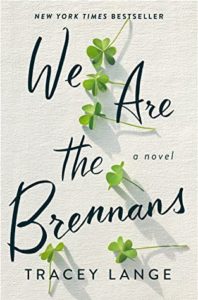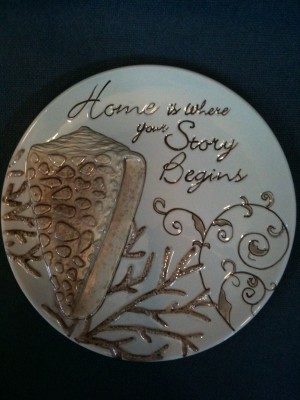In this month’s 6 Degrees of Separation I expressed my love for big, sprawling family sagas. I think that love is one part of my motivation for choosing We Are the Brennans as my July 2021 Book of the Month book. Another motivator was Joyce Carol Oates’s memorable novel We Were the Mulvaneys (scroll down to #11), which I still think about frequently.
Lange, Tracey. We Are the Brennans
Celadon, © 2021
Hardcover, 274 pages
ISBN 978-1-250-79622-6
Recommended
Main Characters
Since this is a family story, it’s necessary to begin with an introduction of the main characters, the three oldest Brennan children plus their long-time friend:
Denny Brennan, the eldest. Formerly the family golden boy, as a teenager he was a good student with the prospect of an athletic career that never materialized because of an injury. He now co-owns and runs a local pub.
Sunday Brennan, the only girl in the family, usually level-headed and dependable. Age 29 as the story opens, she’s the novel’s principal focus character.
Jackie Brennan, known as the family screw-up, a sensitive and artistic man who’s on probation as the story opens.
Kale Collins, best friend of Denny since childhood. Kale’s own mother left home when he was three, leaving Kale with a sickly father who was unable to care for his son adequately. Kale became a constant visitor at the Brennan house and was treated like a member of the family. (Many of the photos of the kids on the walls of the Brennan house include Kale.) Now he’s Denny’s business partner in the ownership and management of one pub and the impending opening of another one in a nearby town.
Plot
The novel opens in Los Angeles, where Sunday is injured while driving drunk. The hospital calls her emergency contact, brother Denny, back in New York. Denny flies to LA and convinces Sunday to come back home, at least temporarily.
We soon learn that home is West Manor, NY, an upper-middle-class town a bit north of Manhattan. Five years earlier Sunday abruptly left home, claiming the offer of a writing job in LA. In the past five years she has been home only once, for just a few days for her mother’s funeral. At the time she left for LA, she was engaged to Kale.
When she finally gets back home, the whole family begins to pressure her for an explanation of why she had left. Kale, badly hurt by her departure with no explanation, had married Vivienne on the rebound, and they now have a son, age three and a half.
The plot continues to thicken quite rapidly. We gradually get the backstory of what had happened to Sunday to cause her to leave. In the present, Denny has been lying about the impending opening of the new business, claiming everything is all set while, in reality, he has had to borrow money from a shady source to finance necessary repairs. Vivienne, knowing how deeply in love Kale and Sunday had been, fears she’ll lose him now that Sunday has returned. Also in the present, Mickey, patriarch of the Brennan family, is beginning to show early signs of dementia, but this condition doesn’t keep him from trying to discover everything that’s going on with everybody so he can help out his family.
Multiple Points of View
All the characters have their own secrets and their own motivations for their actions. These are all well-developed, complex characters. The novel unfolds in chapters each offering a third-person look at one individual’s situation. The reader gets to know this family individually and in aggregate by putting together the information and interpretations of all of them.
Narrative Structure
Lange uses narrative structure to reinforce the picture of the interconnectedness of the Brennan family. Each chapter ends with a bit of dialogue from a character other than that chapter’s focus character. The next chapter then switches to that other character’s repetition of the words and continues with a focus on that character’s perspective of what’s going on.
Minor Characters
Several minor characters serve various functions in fleshing out the story. Mickey Brennan gets a couple of chapters to consider what he thinks he needs to do. He came to the U.S. from Northern Ireland, and we learn some of the story of his life both back in Belfast and here in the U.S.
Maura Brennan, Mickey’s wife, has died before the novel opens, so she doesn’t get any focus chapters. But we learn about her from what the other family members tell us about her statements and actions.
Shane Brennan, the youngest of the adult Brennan children, has what is described as an “intellectual disability.” He is able to hold a job at a local store but must be driven to and from work. His appointments and medications also have to be monitored. The whole family chips in caring for Shane, and his main function is to emphasize how the main characters work together to care for their brother.
Vivienne, Kale’s wife, gets a chapter to herself. She grew up in the poorest section of West Manor, the child of a single mother who works as a waitress. She gives us an idea of how the rest of the town has always viewed the Brennan family as well as contributing substantially to Kale’s behavior after Sunday’s return.
Life Stories in Literature Themes
As soon as the word family appears in the description of a novel, we are inevitably in Life Stories in Literature territory. This novel well illustrates the importance of family in individual’s sense of identity. In many families, each child is described by a certain role: the peacemaker, the flighty one, the responsible one. This is evident in the portrayal of Jackie, who’s on probation when we meet him. He knows that he’s always been thought of as the family screw-up, but in one of his chapters we learn why he’s on probation, a revelation that changes our perception of him.
The keeping of secrets plays a large part in most family stories, and it’s very much in evidence here. In addition, the use of multiple points of view demonstrates how different people interpret the same events differently and how the same statement can mean different things to different people.
Dysfunctional families are a common literary trope, but what sets We Are the Brennans apart from most other novels in this category is its emphasis on a family of people who deeply care about each other while still harboring their own secrets and their individual senses of truth:

“I love writing about a family that is so loving and would do anything for each other but, at the same time, they feel this need to hide their mistakes and flaws, and have secrets. . . . I wanted to explore those two opposing forces, the power of shame versus the power of all this love and loyalty the family feel for each other.”
— Tracey Lange
Yet while we’ve been centered on all the internal family drama, at the periphery of the story someone has been murdered, and several of our characters have a motive for the crime. The Brennan siblings finally have all acknowledged their deceptions and agreed not to keep secrets from each other, but now they face a new problem: weathering the upcoming murder investigation. The novel ends on what looks like a positive note: “There would be a plan and, whatever happened, they would figure it out. Together” (p. 271).
But what does this ending portend? I began reading this novel with We Were the Mulvaneys in mind. But after finishing this novel, I can’t help but focus on the big difference in the two books’ similar titles. In We Were the Mulvaneys the family goes through traumatic experiences and learns lessons from them. By the end of that book, the Mulvaneys of course still have the same last name, but they are no longer the same people they once were. But Lange’s title is in the present tense, We Are the Brennans. By the end of the novel, this title sounds like a defiant declaration, like a circling of the wagons in the face of a threat. I can almost hear a subtitle, uttered by the Brennan siblings in unison: “We are the Brennans. And no one messes with the Brennans.”
© 2021 by Mary Daniels Brown




Like you, I’m a fan of the family saga especially if they involve a dysfunctional (I totally agree with Tolstoy’s “all happy families are alike;” it’s the miserable ones that make great lit!). This one looks pretty good — I’ll keep it in mind.
What drew me in to your review was the reference to oates’ We Were the Mulvaneys. I’m somewhat on the fence about Oates; I’ve only read 5 or 6 of her many, many novels and haven’t always liked them but — Mulvaneys lingered with me for a very long time and I’d consider re-reading it. Obviously, I thought it was tremendous!
Thanks for your comment, Janakay. Like you, I’ve only read a few of Oates’s many, many, many books. The first one I picked up, many years ago, was horror, and I quickly abandoned it. But We Were the Mulvaneys is brilliant, and has stuck with me for several years. But now I’m very selective over which books by JCO that I’ll pick up.